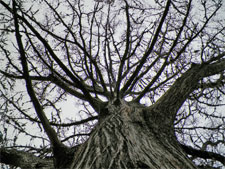Native Son – January, 2013
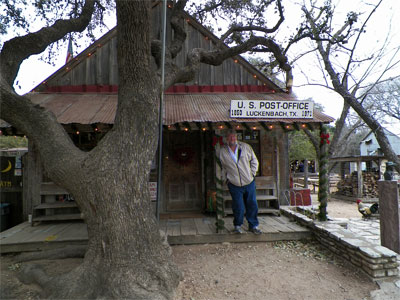
Two roosters enjoying the morning at Luckenbach’s famous porch. All photos courtesy of Steven Chamblee.
Luckenbach, Texas
So I’m sitting in this cavernous room at the Plano Conference Center, with a sea of empty chairs and tables in front of me, and only the muffled sounds of a few folks at the far end packing it up … an unexpected place for a sudden moment of introspection, or maybe the perfect place. The 2013 Neil Sperry Landscape School is over, and my mind is filled with thoughts of the day. Contentment at what I remembered to say, and a tinge of regret for a few things that I forgot to say; reminiscent of the pangs of parenthood, when you see your kid walking off into the world. How can one possibly say it all? How can you convey years of observations and successes and mistakes and lessons learned into a single day of landscape school? How can you boil it all down to the basics?
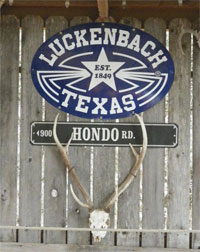
Backdrop to one of the tiny bandstands around Luckenbach.
Like a divine answer from God himself, the gentle swooning of a 1950 Fender Broadcaster begins to fill my mind, and Waylon Jennings sings … “maybe it’s time to get back to the basics of love.” Maybe the real secret to peace/contentment is as simple as, well, ”simple.” Our world is complex, and getting more so every second. We all need a place to recharge — an oasis from our problems. Interestingly enough, a true oasis provides for your basic needs and little or nothing else. Perhaps less really is more, and paring down all of these excesses/luxuries can lead us to an uncluttered mind, a more content spirit. In the song, “Luckenbach, Texas,” Jennings tells of how the everyday world is straining and draining his life, so he heads out to Luckenbach to rediscover simplicity. Hmmm…sounds like a dadgum good idea to me.
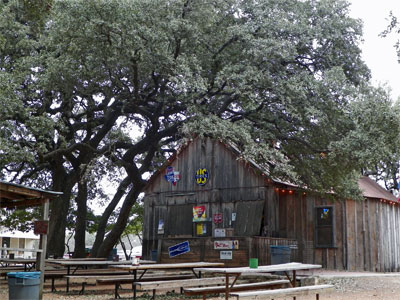
Old barns and live oaks.
Mid-morning in Luckenbach is nothing less than magical. Chickens scratching around under the canopy of majestic live oaks; oaks that seem to reverently understand that the old wooden buildings beneath are made of their ancestors. A bit of wood smoke hangs romantically in the air, and every stranger you meet somehow seems like your friend. You take pictures of each other on the porch, under that famous “Post Office” sign. You take your time, time to really look at things … the echoing arcs in the live oak branches, handrails worn smooth by those who came before, and even the dirt under your feet. This is good dirt. It has provided for and nursed everything around you. It is part of Mother Earth, who sustains us and everything else on this little orb floating in space. A contented smile gently lands upon your lips, a quiet confirmation that you are indeed a part of something so big and so wonderful. You walk slowly, deliberate yet unhurried, toward a little wooden bridge that crosses a small dry ravine. Beyond lies treasure? You pause a bit to ponder this, then realize that no matter what you find over there, it is indeed treasure, for in this moment you are fully and truly alive.
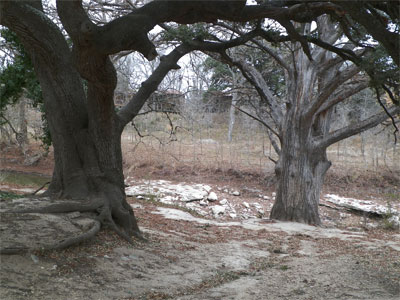
Brothers from different mothers.
A hundred soft footpads later, two colossal trees rise up from the earth like sentinels. They are brothers from different mothers, sharing not genetics, but time, space, earth, and water. The massive, multi-trunk live oak erupts up and splays out horizontally like a cloud. The cypress rockets up in twin trunks to over 90 feet. At their feet, a small tributary called Grape Creek holds a handful of water, the source of their gigantism. I sit on the soft ground and quietly observe this environment … no, this landscape … no, this oasis.

The majestic live oak.
I ask myself if this live oak is a Coastal Live Oak or an Escarpment Live Oak. I decide it doesn’t matter to me. I look over and wonder if this cypress tree is a Baldcypress or Montezuma Cypress. For whatever reason, this does seem to matter to me. While superficially alike, the two cypresses have a few inherent differences. Baldcypress occurs naturally in moist soils from Central Texas to Illinois (interestingly enough, skipping North Central Texas), and from Florida to Delaware. Montezuma Cypress’s native range is from the very southern tip of Texas (Hildago and Cameron counties) through Mexico into Guatemala, and almost exclusively along stream and river banks. (The Mexican name for this tree is Ahuehuete, from the Aztec language Nahuatl, meaning “old man of the water.”) Baldcypress trees form those famous “knees” in saturated soils, while Montezuma Cypresses do not. So much for the visible differences. (Modern scientists, armed with DNA research capabilities, recognize the overwhelming similarities, and have lumped Baldcypress and Montezuma Cypress into a single species, along with Pond Cypress, known botanically as Taxodium distichum var. distichum, T. distichum var. mucronatum, and T. distichum var. ascendens, respectively.) I chuckle aloud at the thought of how different my brothers and I look, and how we might be classified by scientists.
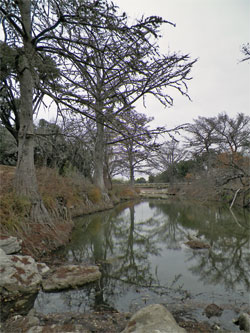
A view down Grape Creek.
So here I am, sitting on the edge of tiny little Grape Creek, checking out this massive cypress tree, and I get to thinking that, while “genetically allied” closer to the cypresses of Mexico (and the famous ones along the San Antonio Riverwalk), this tree actually has more in common with the nearby live oak. Together, they have survived the same droughts, floods, storms, fires, pestilence, and human intervention. Together, they have experienced the same gentle rains, sunny days, cool breezes, and human adoration. Together, these brothers from different mothers have shared a piece of earth for a few hundred years, each remaining true to himself while peacefully dividing the resources at hand. Seems all they really need is time, space, earth, and water. Maybe that’s all any of us really need. Seems pretty simple.
I hope the landscape school students read this.
About the author: Steven Chamblee is the chief horticulturist for Chandor Gardens in Weatherford and a regular contributor to Neil Sperry’s GARDENS magazine and e-gardens newsletter. Steven adds these notes:
Start your new year right with a visit to Chandor Gardens. Winter exposes the bones of the garden, and colorful birds make bare branches an ever-changing display. Just take I-20 west to exit 409, hang a right, go 2.1 miles and hang a left on Lee Avenue. Head straight 12 blocks and you’re driving in the gates. Call 817-361-1700 for more information. You can always go to www.chandorgardens.com for a picture tour and details.
I can always use another road trip! Let me know if you’d like me to come out and speak to your group sometime. I’m low-maintenance, flexible, and you know I like to go just about anywhere. No city too big; no town too small. Just send me an e-mail at schamblee@weatherfordtx.gov and we’ll work something out.


